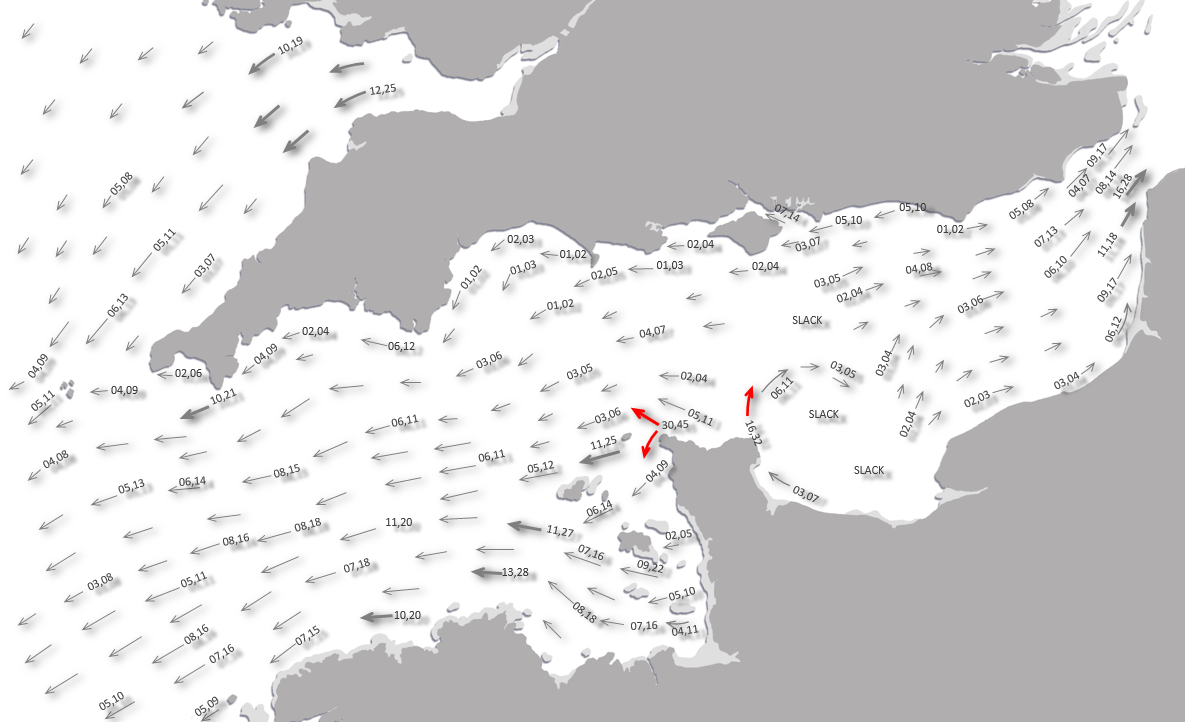_stitch.jpg)
Nestled up a river and more than ten miles from the sea the marina offers complete protection. Attentive navigation is required for access and it is shallow making it more suited to moderate to shallow draft vessels that are prepared to work the tides.

Keyfacts for Ridge Wharf Yacht Centre
Facilities



















Nature



Considerations


Protected sectors
Approaches


Shelter


Last modified
July 18th 2018 Summary
A completely protected location with attentive navigation required for access.Facilities



















Nature



Considerations


Position and approaches
Expand to new tab or fullscreen
Haven position
 50° 41.068' N, 002° 5.303' W
50° 41.068' N, 002° 5.303' WThis is the position of the Ridge Wharf Yacht Centre fuel dock
What are the key points of the approach?
Offshore details are available in the westbound  or eastbound
or eastbound  sequenced 'Selsey Bill to Start Point' coastal description. Entry into Poole Harbour and the run up to Poole are covered in the Poole Town Quay
sequenced 'Selsey Bill to Start Point' coastal description. Entry into Poole Harbour and the run up to Poole are covered in the Poole Town Quay  entry. The continuation up the Wareham Channel and the River Frome is covered in the Wareham
entry. The continuation up the Wareham Channel and the River Frome is covered in the Wareham  entry.
entry.
 or eastbound
or eastbound  sequenced 'Selsey Bill to Start Point' coastal description. Entry into Poole Harbour and the run up to Poole are covered in the Poole Town Quay
sequenced 'Selsey Bill to Start Point' coastal description. Entry into Poole Harbour and the run up to Poole are covered in the Poole Town Quay  entry. The continuation up the Wareham Channel and the River Frome is covered in the Wareham
entry. The continuation up the Wareham Channel and the River Frome is covered in the Wareham  entry.
entry.- Once sufficient water is assured follow the well-marked channels all the way up to Ridge Wharf Yacht Centre.
Not what you need?
Click the 'Next' and 'Previous' buttons to progress through neighbouring havens in a coastal 'clockwise' or 'anti-clockwise' sequence. Below are the ten nearest havens to Ridge Wharf Yacht Centre for your convenience.
Ten nearest havens by straight line charted distance and bearing:
- Redclyffe Yacht Club - 0.5 nautical miles WSW
- Wareham - 0.8 nautical miles W
- Shipstal Point - 2.5 nautical miles ENE
- Lake Yard Marina - 3 nautical miles ENE
- Poole Yacht Club - 3.7 nautical miles ENE
- Brownsea Island - 3.8 nautical miles E
- Goathorn Point - 4 nautical miles E
- Cobb's Quay - 4 nautical miles ENE
- Port of Poole Marina - 4.1 nautical miles ENE
- Poole Town Quay - 4.2 nautical miles ENE
These havens are ordered by straight line charted distance and bearing, and can be reordered by compass direction or coastal sequence:
- Redclyffe Yacht Club - 0.5 miles WSW
- Wareham - 0.8 miles W
- Shipstal Point - 2.5 miles ENE
- Lake Yard Marina - 3 miles ENE
- Poole Yacht Club - 3.7 miles ENE
- Brownsea Island - 3.8 miles E
- Goathorn Point - 4 miles E
- Cobb's Quay - 4 miles ENE
- Port of Poole Marina - 4.1 miles ENE
- Poole Town Quay - 4.2 miles ENE
Chart
How to get in?

Ridge Wharf Yacht Centre is situated on the south bank of the River Frome about a ½ mile upstream of Swineham Point where it properly opens. It has 170 pontoon berths and can accommodate yachts of up to 15.2 metres LOA with drafts of up to 1.4 metres.
The channel through the River Frome is navigable to Ridge Wharf Yacht Centre for moderately sized craft drawing up to 1.5 metres, 1.4 metres being more advisable, making an approach at high water ± 1 hour.
Ridge Wharf Yacht Centre Quay has as little as 0.8 metres chart datum. However low water does not tend to fall below 1.2 metres except under very low river flow conditions. The majority of its berths dry out to soft mud.
The marina holds only a limited number of visitor berths. Therefore it is advisable to make contact in advance to check availability P: +44 1929 552650, between 0900 and 1800. Alternatively email E: office@ridgewharf.co.uk

 Entry into Poole Harbour and the run up to Poole are covered in the Poole Town Quay
Entry into Poole Harbour and the run up to Poole are covered in the Poole Town Quay  entry. The continuation up the Wareham Channel and the River Frome are covered in the Wareham
entry. The continuation up the Wareham Channel and the River Frome are covered in the Wareham  entry.
entry.
 Berth as directed by the marina’s berthing officer. If no prior arrangements have been made come alongside the pontoon and make enquiries.
Berth as directed by the marina’s berthing officer. If no prior arrangements have been made come alongside the pontoon and make enquiries.
Why visit here?
Ridge Wharf began its life transhipping Purbeck Ball Clay brought here by a light railway from the weathering beds of nearby Furzebrook.Purbeck Ball Clay has been used for thousands of years but large scale commercial extraction began in the middle of the 18th century. The clay was taken by horse to Wareham, from where it was shipped by barge to Poole Harbour. When in 1791 William Pike signed a contract to supply the legendary Staffordshire Wedgewood pottery, the volume of clay gradually rose in the following decades to overwhelm the capacity of the established horse drawn system.
It was a company called the ‘Pike Bros’, the sons of William Pike, that would provide the solution in the form of a narrow gauge industrial railway. The practice of hauling clay by light rail had been long since established by the ‘Pike Bros’ nearest competitor Benjamin Fayle. He had built the Middlebere Plateway as early as 1806, Dorset's first railway at the time, to draw his clay to Middlebere Wharf on the southern shore of Poole Harbour. Taking this template the ‘Pike Brother’s set about the construction of their own light rail to bring their Furzebrook ball clay workings to the then specially created Ridge Wharf by light rail.
The Furzebrook Railway, that was also known locally as the the ‘Pike Brothers' Tramway’, was built in 1840 from the clay pits around Grange Gate from where it continued to the northeast, crossing the road to Kimmeridge Bay, after which it then turned northward for the last couple of miles to the Furzebrook processing works, storage depot and loading pier at Ridge Wharf. Here the clay was then transferred by barges for transhipment at Poole Harbour where it completed the final leg of its passage to the Wedgwood factories in Staffordshire.

In 1902 interchange sidings were built between Corfe Castle and Worgret Junction at Furzebrook, and Norden for Goathorn Point’s ‘Newton Tramway’, to enable the ball clay to be exported by the Wareham to Swanage branch line that had been established in 1885. A new locomotive shed and workshop was built at the interchange point at this time. The Ridge branch was commandeered by the wartime government in 1940 and closed down. During the war it served as a build and repair centre for torpedo boats. After the war the Ridge section never reopened but the rest of the system, and its outlying mines and clay-pits, carried on operating until 1956 when it was finally closed. By this time road transport had removed the need for the tramway. British Rail kept the three mile line between Worgret Junction and Furzebrook operational for the export of oil and gas from the Wytch Farm oilfield until 2005.
Ridge Wharf Marina and Boatyard was established on the site in 1965 and, under the careful custodianship of the same family for over 35 years, it has grown to provide a wide range of services. The line's engine shed at Ridge can still be seen there today and is a listed building. The route of the line from Ridge to Furzebrook can be traced on the ground and on maps. The second of the Furzebrook Railway’ trains, Secundus, is on display in the Swanage Railway museum at Corfe Castle station. The No.28 wagon, a 1865 sledge-braked design example, one of the one hundred locally built wagons of the Furzebrook Tramway, also survives and is on display at the Narrow Gauge Railway Museum at Tywyn, North Wales.

For the visiting boatman Ridge Wharf provides a remote rural berth in an area of outstanding natural beauty. This makes for a quiet, relaxed and enchanting out-of-the-way feeling where one can enjoy a peaceful time and a good night’s sleep. With its highly capable yard it is also an ideal location to have some repair work attended to.

Being only thirty minute’ walk from Wareham, half of this along a delightful riverside walk, and marginally deeper than the town quay, it is a good place to explore the historic town detailed in the Wareham entry. For those who would prefer not to walk, or are intent on re- provisioning, Wareham is just a mile and a half upriver by dinghy.
What facilities are available?
Power and water are available on the pontoons, toilet and shower facilities ashore. Diesel and unleaded petrol are available at the fuel dock and gas cylinders may be obtained at the Marina office. There is a self-launch slipway on the site that caters for vessels of up to 6.2 metres.The yard has a 25 tonne travelling hoist and it provides winter lay-up facilities ashore including a storage area for trailer boats. The marina has a fully serviced boatyard with a chandler onsite and a wide range of specialist services including full sub-contractor back up for rigging, engineering, sailmaking etc.
With thanks to:
John Binder CMM Poole Quay Boat Haven & Port of Poole Marina manager. Photography with thanks to Michael Harpur.Ridge Wharf Yacht Centre & Boat Yard
Add your review or comment:
Please log in to leave a review of this haven.
Please note eOceanic makes no guarantee of the validity of this information, we have not visited this haven and do not have first-hand experience to qualify the data. Although the contributors are vetted by peer review as practised authorities, they are in no way, whatsoever, responsible for the accuracy of their contributions. It is essential that you thoroughly check the accuracy and suitability for your vessel of any waypoints offered in any context plus the precision of your GPS. Any data provided on this page is entirely used at your own risk and you must read our legal page if you view data on this site. Free to use sea charts courtesy of Navionics.



 +44 1929 552650
+44 1929 552650 office@ridgewharf.co.uk
office@ridgewharf.co.uk ridgewharf.co.uk/
ridgewharf.co.uk/








